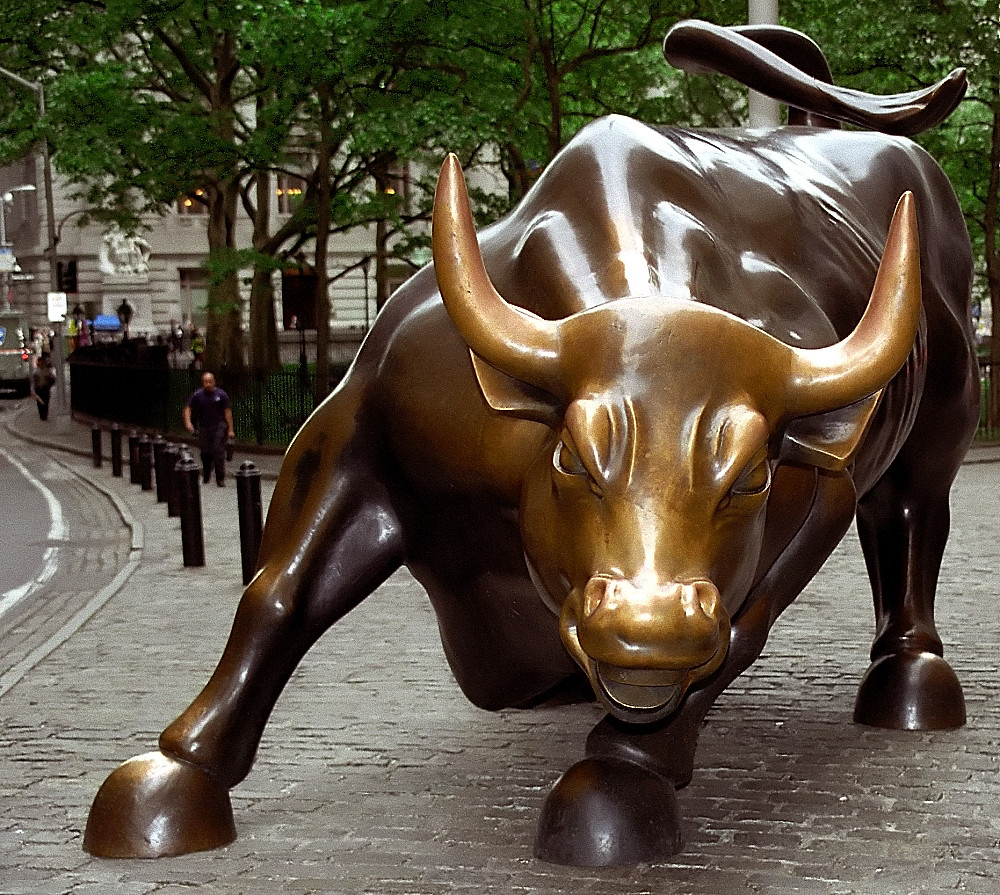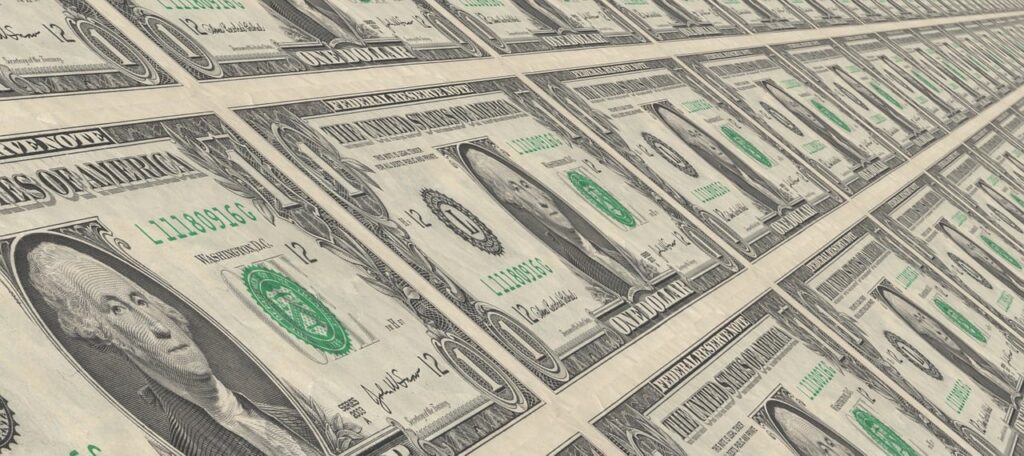
Wall Street is grappling with a significant downturn, as major U.S. stock indexes experience sharp declines and investors navigate a landscape of heightened uncertainty. The S&P 500 has retreated notably from its recent all-time high, while the Nasdaq Composite confirmed a correction, reflecting widespread investor anxiety. This market turmoil underscores a critical period of reassessment for financial participants, who are closely scrutinizing economic signals and policy implications.
At the heart of this volatility are concerns surrounding U.S. President Donald Trump’s tariff policies and his administration’s broader economic agenda. His refusal to predict whether these policies could lead to a recession has amplified investor unease, leading to a palpable shift in sentiment. The financial community, initially expecting a pro-business environment, is now confronting a reality marked by potential economic “detox” and structural changes that introduce friction and uncertainty into the marketplace.
The current sell-off is not merely a statistical anomaly but a complex interplay of political rhetoric, economic indicators, and evolving market expectations. Analysts and portfolio managers across the industry are offering a range of perspectives, highlighting factors from overvalued tech stocks and unwinding carry trades to a re-evaluation of the administration’s priorities. This in-depth analysis will explore the primary drivers behind Wall Street’s current disposition, examining why investors are increasingly preparing for a potentially rough patch ahead.
1. **The Overarching Shadow of Tariff Policies and Uncertainty**The most immediate and profound catalyst for the recent market sell-off has been the Trump administration’s aggressive stance on tariff policies and the resulting economic uncertainty. President Trump’s reluctance to forecast a recession when questioned about his tariff policies has only exacerbated investor concerns, creating an environment where future economic outcomes are perceived as increasingly opaque. This ambiguity has directly translated into market anxiety, as businesses and investors struggle to anticipate the long-term impact of these trade measures.
Chris Larkin, managing director, trading and investing, at E-Trade from Morgan Stanley, succinctly captured this sentiment, stating, “There are always multiple forces at work in the market, but right now, almost all of them are taking a back seat to tariffs.” This observation underscores how trade policy has become the dominant narrative, overshadowing other market fundamentals and dictating daily market movements. The market’s reaction suggests that the perceived benefits of other policies are being outweighed by the friction introduced by tariffs.
The S&P 500’s volatility is a direct reflection of this tariff-driven uncertainty, with the index experiencing significant swings, up or down, multiple times in a short period. This pattern of “on-and-off-again tariffs” contributes to a sense of instability that risks driving U.S. companies and consumers into an “economy-freezing paralysis.” The core worry is that these unpredictable policy shifts will either directly harm economic activity or create such a high degree of uncertainty that investment and spending decisions are deferred or abandoned.

2. **Wall Street’s Shattered Expectations**Donald Trump’s initial ascent to the presidency was met with widespread optimism on Wall Street, with many expecting a decidedly pro-business, pro-growth, and regulation-lite environment. JPMorgan Chase CEO Jamie Dimon, for instance, had expressed a view that bankers would be “dancing in the street” following the election. This initial enthusiasm was based on expectations of lower taxes and less stringent regulation, policies believed to foster economic expansion and corporate profitability.
However, the reality of the administration’s policies has presented a stark contrast to these early expectations. The implementation of ramping tariff policies, which many analysts are now beginning to frame as a form of tax, coupled with “cost-cutting austerity measures in the form of the Department of Government Efficiency,” has diverged significantly from the anticipated playbook. This “chasm between expectation and reality” is identified by Jake Manoukian, JPMorgan Private Bank’s U.S. head of investment strategy, as being “at the root of Wall Street’s woes.”
Manoukian noted that “the first … 50 days of Trump is almost the opposite of what the expectations were in November, December, January.” This disconnect became particularly acute given that the S&P 500 was trading at a high 22 times forward P/E multiple, having already “baking in a lot of enthusiasm around an acceleration in corporate earnings and a re-engagement of capital market activity.” The current sell-off, therefore, is largely a realignment as the market digests these misaligned expectations, particularly impacting “the most popular, highly valued names” that had benefited most from the initial optimism.
3. **The Pervasive Market Volatility**The U.S. stock market has recently entered a period characterized by significant and unsettling volatility, transforming what began as a routine pullback into a phase of heightened investor concern. The S&P 500, Dow Jones Industrial Average, and Nasdaq Composite have all experienced sharp declines, with the S&P 500 dropping notably from its all-time high set just last month, and the Nasdaq confirming a correction by falling over 10% from its recent peak.
This tumultuous period is marked by “whipsaw moves,” where the S&P 500 has swung more than 1%, up or down, multiple times in a concentrated span. Such erratic market behavior creates an environment of profound uncertainty, threatening to impede economic activity. The primary apprehension is that these swift and unpredictable shifts will either directly harm the economy through their immediate financial impact or generate sufficient anxiety to cause businesses and consumers to halt spending and investment, leading to an “economy-freezing paralysis.”
Joe Saluzzi, co-founder of Themis Trading, commented on this, stating, “At this point the problem is the uncertainty, so we’ll see what happens.” This sentiment highlights that the lack of a clear outlook is as detrimental as any specific negative economic data point. The market is struggling to find a stable footing as it attempts to price in the implications of ongoing policy decisions and their potential to introduce friction and structural changes, as observed by Michael O’Rourke of Jonestrading, leading to understandable investor caution and profit-taking.
Read more about: Beyond Gold: Unveiling the Next Generation of Wealth-Building Opportunities in High-Growth Sectors and Alternative Investments

4. **Signals of Economic Weakening**Beneath the surface of market volatility, concrete signals of economic weakening are emerging, contributing to Wall Street’s growing concerns about a potential recession. While the U.S. job market still shows “stable hiring at the moment” and the economy “ended last year running at a solid rate,” several indicators point towards a deceleration. This divergence between past performance and future outlook is fueling investor pessimism and calls for caution.
One significant signal comes from surveys that reveal “increased pessimism” among economic participants. Such shifts in sentiment are crucial, as economies are not immune to the fears or hopes of their human components. Should this pessimism translate into reduced business investment and consumer spending, it could create a self-fulfilling prophecy of a downturn. This psychological aspect of the economy is a key risk going forward, as declines in the stock market could further erode confidence.
Furthermore, a “widely followed collection of real-time indicators compiled by the Federal Reserve Bank of Atlanta suggests the U.S. economy may already be shrinking.” This specific data point, stemming from an authoritative source, provides a more tangible and alarming indication of a potential slowdown. While a classical recession definition typically requires two straight quarters of declining gross domestic product, these early warnings suggest that underlying conditions are shifting in a concerning direction, prompting investors to reassess their positions and prepare for potential economic contraction.
Read more about: Unmasking the Trust Deficit: Why Car Dealerships Are Struggling to Connect with Today’s Buyers and How They Can Rebuild Confidence

5. **Treasury Secretary Bessent’s “Detox” Period**Adding another layer to the market’s current anxiety is the White House’s articulated strategy for the economy, which includes a period of “detox.” Treasury Secretary Scott Bessent has described this as a necessary phase during which the economy will “wean itself off an addiction to spending by the government.” This approach signals a significant shift towards fiscal conservatism and austerity measures, intended to reshape the nation’s economic fundamentals.
The White House’s commitment to limiting federal spending, coupled with plans to cut the federal workforce and increase deportations, represents a deliberate effort to enact “structural change.” While these policies are framed by the administration as steps toward “bringing wealth back to America” and fostering long-term prosperity, they inherently introduce short-term friction and uncertainty. President Trump himself acknowledged this, stating, “There is a period of transition because what we’re doing is very big… It takes a little time.”
For Wall Street, however, this “detox” period carries immediate implications. The reduction in federal spending and workforce could hinder the job market, potentially offsetting the stable hiring seen currently. Such measures, while perhaps intended to strengthen the economy in the long run, are viewed by some as “taking a hammer to the economy” to achieve specific goals, such as bringing down the 10-year yield. This pursuit of broader objectives, even at the cost of market disruption, signifies a new dynamic that investors are struggling to fully price in, as Edward Al-Hussainy noted, the administration’s definition of a ‘win’ may not align with market performance.
6. **Economists Downgrading Growth Forecasts**The mounting concerns on Wall Street are being validated by a discernible trend among economists: the downgrading of U.S. economic growth forecasts. This revision reflects a growing consensus that the economic outlook has dimmed, primarily due to the ongoing policy uncertainty and the anticipated impact of tariffs. Such adjustments by leading financial institutions provide a quantitative underpinning to the market’s qualitative anxieties.
Goldman Sachs, for instance, has significantly revised its projections. David Mericle, an economist at the firm, cut his estimate for U.S. economic growth to 1.7% from 2.2% for the end of 2025 over the year prior. This substantial reduction is “largely because tariffs look like they’ll be bigger than he was previously forecasting.” The direct link between escalating trade policies and a weakened growth outlook highlights the tangible economic costs associated with the current administration’s approach.
Mericle also updated his assessment of recession probability, now seeing a “one-in-five chance of a recession over the next year.” While this represents only a slight increase, it signifies a heightened level of risk compared to prior expectations. Crucially, he added a caveat: “the White House has the option to pull back policy changes” if economic risks “begin to look more serious.” This statement suggests that the current trajectory is largely policy-dependent, with a potential off-ramp available should the economic pain become too severe, leaving investors in a state of watchful anticipation.
7. **The Vulnerability of Big Tech and High-Growth Stocks**The current market turbulence has disproportionately impacted some of Wall Street’s biggest stars, particularly companies within the Big Tech sector and those that have recently benefited from the artificial intelligence (AI) frenzy. These high-valuation growth stocks, once the darlings of the market, are now experiencing significant pullbacks, contributing substantially to the overall market sell-off and highlighting their inherent sensitivity to risk sentiment and economic uncertainty.
The Nasdaq Composite, which is heavily weighted towards technology stocks, has been particularly hard hit, closing down more than 4% on one recent Monday and confirming a correction from its December record high. Art Hogan, Chief Market Strategist at B Riley Wealth, noted that “The damage around markets that has everything to do with sentiment is reflected more in the Nasdaq, because technology stocks are certainly more influenced by risk sentiment.” He added that “De-risking also tends to take you out of the high beta names which are in the Nasdaq,” indicating a broader flight from riskier assets.
Individual examples underscore this trend dramatically. Nvidia, a key beneficiary of the AI boom, fell another 5.1% in one day, bringing its loss for the year to over 20% after an astonishing nearly 820% surge over 2023 and 2024. Elon Musk’s Tesla also suffered, plunging 15.4% and deepening its 2025 loss to 45%. The context notes that after an initial “post-election bump on hopes that Musk’s close relationship with Trump would help the electric-vehicle company, the stock has slumped on worries that its brand has become intertwined with Musk” and even targeted by protests. This illustrates how even perceived political alignments can become a liability when market sentiment shifts against high-profile, high-valuation assets amidst an uncertain economic and policy environment. Ross Mayfield of Baird also pointed out that tech stocks have “very extended valuations trading at pretty big premiums to the broader market,” making them prone to “air pockets” and further weakness in the near term.
8. **The Federal Reserve’s Pivotal Role and Anticipated Actions**The Federal Reserve’s stance on interest rates remains a critical determinant for market direction, particularly as investors grapple with heightened uncertainty. The prevailing sentiment on Wall Street indicates an expectation of “two to three rate cuts this year,” signaling a belief that the central bank will intervene to support economic activity amidst current pressures. The market keenly watches for any “negative prints” in economic data that could prompt the Fed to become “more active and quicker” in its policy adjustments.
However, the Fed faces a delicate balancing act. While rate cuts could provide a much-needed stimulus, there is a distinct reluctance among policymakers to make emergency moves. Analysts caution that such an intervention, outside of scheduled meetings, could inadvertently “frighten people and causing a market meltdown,” exacerbating rather than alleviating investor anxiety. The traditional September meeting is the anticipated venue for any significant policy shifts, barring a severe and undeniable market collapse.
Indeed, the question of “what is the response going to be from the Fed?” looms large over market participants, as noted by George Cipolloni, portfolio manager at Penn Mutual Asset Management. The central bank’s perceived reluctance to cut interest rates, which have successfully “throttled inflation,” has also “weighed down businesses and consumers.” This creates a scenario where the Fed’s next steps are not merely reactive but will actively shape the market’s trajectory and the broader economic narrative.
Therefore, the market remains in a state of watchful anticipation, with its health closely tied to the Federal Reserve’s future decisions. Any divergence from expected policy, or a perceived misstep in timing, could amplify the existing volatility. The intricate dance between economic data, market sentiment, and central bank action is poised to define the coming quarters.
Read more about: Navigating the Fed’s Rate Cut: A Comprehensive Guide to How Monetary Policy Will Reshape Your Mortgage and Finances for the Next Decade

9. **The Administration’s Shifting Definition of ‘Winning’**Wall Street initially anticipated a decidedly pro-business environment under the current administration, fostering expectations of policies that would directly bolster corporate earnings and market performance. However, this initial optimism has given way to a stark realization that the administration’s definition of “winning” may diverge significantly from traditional market metrics. Edward Al-Hussainy, a senior interest rate and currency analyst, succinctly stated that “This administration does not know how to define a win,” asserting that they “don’t care about where the stock market is.”
This shift represents a significant “wake-up call for Wall Street,” as articulated by Ross Mayfield, investment strategist at Baird. There was a prevalent “sense that President Trump kind of measured his success on stock market performance,” fostering a belief in a “Trump put”—an implicit guarantee of policy support to prevent severe market downturns. However, the current economic strategy suggests this is “not the case,” and the market is now adjusting to this new reality.
The administration’s “broader goals” appear to transcend immediate stock market gains, focusing instead on “bringing wealth back to America” through “structural change” and a period of economic “detox.” These objectives, while framed as long-term benefits, inherently introduce “friction and uncertainty” in the short term. The willingness of the administration to potentially “engineer more downside risk to growth” to achieve objectives like lower Treasury yields underscores a strategic recalibration that Wall Street is still trying to comprehend.
Ultimately, the financial community is confronting an administration whose primary concerns are less about the 10-year Treasury yield or daily market movements and more about defining political and economic victories over a different timeframe. This fundamental divergence between Wall Street’s desires and the White House’s priorities means investors must contend with an environment where market performance is not necessarily the ultimate arbiter of policy success.
Read more about: Andrew Cuomo: Charting a Divisive Political Trajectory from Queens to New York’s Pinnacle
10. **The Unwinding of Global Carry Trades and Capital Flight**A notable and concerning development in the current market climate is the observable unwinding of global carry trades, signaling a broader retreat of international capital from U.S. markets. Dennis Dick, a trader at Triple D Trading, highlighted this trend, noting that “International investors are coming out of the U.S. markets and they’re going elsewhere. Today, it’s flying out of everything.” This phenomenon represents a significant shift in global capital flows, as investors reallocate funds away from what were once attractive, higher-yielding U.S. assets.
The “carry trade,” where investors borrow in low-interest-rate currencies to invest in higher-yielding ones, thrived during periods of perceived stability and strong U.S. outperformance. However, with increasing uncertainty and potential economic slowdowns, this strategy becomes riskier, leading to rapid liquidation. Thomas Hayes, chairman at Great Hill Capital LLC, directly linked this unwinding to market movements, stating, “The carry trade is unwinding, and all that hot money was in Mag 7. So that’s why tech is down.” This illustrates how the impact of this global deleveraging disproportionately affects high-growth, high-valuation sectors.
The swiftness and scale of this capital flight are concerning, with Dick warning that “This isn’t something that just unwinds in a day or two, you could see this get ugly.” The implications extend beyond immediate market volatility, suggesting a structural realignment of global investment portfolios. As capital seeks new homes, the pressure on U.S. assets could persist, contributing to a more challenging environment for domestic equities and other risk assets.
Moreover, the re-evaluation of U.S. market appeal is pushing investors to reconsider their long-held preferences. As Ross Mayfield of Baird noted, there’s a need to “revisit is my preference for US (stocks) over international,” given that “the pressure that the Trump administration is putting on foreign governments… has actually, in a lot of cases, resulted in outperformance from those countries.” This dynamic reallocation signifies a move towards diversifying geographic risk and seeking value in previously overshadowed international markets.
11. **The Rise of Safe-Haven Assets: Treasury Bonds**Amidst the widespread market turbulence and economic uncertainty, investors are strategically repositioning their portfolios by flocking to traditional safe-haven assets, most notably U.S. Treasury bonds. This shift reflects a clear preference for stability and capital preservation over higher-risk, growth-oriented investments when the economic outlook appears cloudy. As markets question how much “pain President Donald Trump will let the economy endure,” the allure of government-backed securities strengthens.
This increased demand for Treasuries has predictably sent their prices sharply higher, consequently driving down their yields. The yield on the 10-year Treasury, a key benchmark, has tumbled notably to 4.22% from 4.32% late Friday, continuing a descent from nearly 4.80% in January. Such a “major move for the bond market” underscores the gravity of investor concerns and their collective pivot towards perceived safety.
Interestingly, this decline in yields aligns, in part, with stated administration objectives. Treasury Secretary Scott Bessent had expressed a desire for the 10-year yield to come down, suggesting that “you can take a hammer to the economy and certainly impact it.” While this approach might carry a “cost” in terms of market disruption, the administration’s perceived success in lowering rates, as George Cipolloni remarked, highlights a complex interplay between policy goals and market outcomes.
Edward Al-Hussainy further elucidated this, suggesting that “if you engineer more downside risk to growth, you don’t actually have to do it, but you just engineer the risk, then you’re going to bring down your yields.” This demonstrates that even the *perception* of economic vulnerability can achieve certain policy aims by driving capital into safe havens. For investors, U.S. Treasury bonds have become the primary refuge, reflecting a collective judgment that current economic headwinds necessitate a more conservative stance.

12. **Impact on Other Asset Classes: Cryptocurrency and Volatility**The current wave of investor caution and de-risking extends far beyond the traditional stock market, impacting a diverse range of asset classes that once boasted seemingly unstoppable momentum. Even highly speculative investments, such as cryptocurrencies, are experiencing significant pullbacks, highlighting a broad-based flight from risk. This indicates that the market’s reassessment of value and risk appetite is pervasive.
Bitcoin, a prominent example of this trend, has seen its value drop below $80,000 from a high of “more than $106,000 in December.” This steep decline underscores how capital that once flowed into such volatile assets is now being withdrawn, as investors prioritize stability. The narrative of “de-risking” captures this movement, wherein investors divest from “high beta names” and speculative ventures in favor of more secure holdings.
Across the investment landscape, prices are “sending prices lower for all kinds of investments whose momentum had earlier seemed nearly impossible to stop at times.” This includes not only cryptocurrencies but also other assets where valuations had become stretched or where sentiment-driven speculation played a significant role. The shift reflects a more sober approach to portfolio construction, where the anticipation of economic headwinds outweighs the pursuit of aggressive returns.
This widespread retreat from riskier assets illustrates the depth of investor anxiety surrounding the current economic outlook. It suggests that market participants are not merely trimming positions but fundamentally re-evaluating the risk-reward profiles across their entire portfolios. The era of easy gains in highly speculative assets appears to be receding as market forces recalibrate for a more uncertain future.

13. **Re-evaluating U.S. Exceptionalism and International Markets**For a considerable period, the U.S. market has enjoyed an era of “U.S. exceptionalism,” massively outperforming many international counterparts. This sustained dominance led many investors to heavily weight their portfolios toward domestic equities. However, the current market dynamics, coupled with the administration’s trade policies, are prompting a fundamental re-evaluation of this preference, pushing investors to consider opportunities elsewhere.
Michael O’Rourke of Jonestrading noted this shift in perspective, suggesting that “you could go invest in other places of the world with much lower multiples and maybe at least not be exposed to the expensive valuations of the U.S.” This indicates a growing awareness that while the U.S. undergoes its “structural shift” and experiences heightened volatility, other global markets may offer more attractive entry points and less exposure to immediate policy-driven friction.
Intriguingly, the very pressures exerted by the Trump administration on foreign governments have, in some instances, inadvertently led to outperformance in those regions. Ross Mayfield of Baird pointed out that the administration’s actions have, “in a lot of cases, resulted in outperformance from those countries (such as) China and Europe.” This counterintuitive outcome suggests that global capital flows are adapting to the new geopolitical and economic landscape, seeking stability and growth where it can be found.
Consequently, investment strategists are actively revisiting their allocation models. Mayfield affirmed, “That’s a place we’re revisiting to decide if we think it’s something more structural or just a short term trade.” This introspective analysis signifies a potential long-term shift away from an almost exclusive focus on U.S. markets, advocating for a more diversified and globally attuned investment strategy that acknowledges evolving international dynamics.
14. **Wall Street’s Newfound Acceptance of Economic “Pain”**The most striking realization dawning on Wall Street is the administration’s apparent acceptance, and perhaps even strategic embrace, of economic “pain” as a necessary component to achieve its broader policy goals. President Donald Trump’s reluctance to predict a recession when questioned about his tariff policies, coupled with statements about a “period of transition” for “bringing wealth back to America,” signals a willingness to endure short-term economic friction for long-term objectives.
This contrasts sharply with the prior perception that the President would always prioritize a robust stock market as a measure of his success. Ross Mayfield of Baird underscored this shift, noting, “The Trump administration seems a little more accepting of the idea that they’re OK with the market falling, and they’re potentially even OK with a recession in order to exact their broader goals.” This perspective represents a significant departure from the market’s past assumptions.
As George Cipolloni, portfolio manager, observed, the administration’s methods for achieving objectives like lower 10-year yields might involve “taking a hammer to the economy.” While these actions have demonstrably impacted markets and led to a “trillion dollars out of crypto, or tons of money out of the stock market,” they are framed as deliberate steps towards “structural change.” The explicit acknowledgment of a “transition” period by the President further reinforces this commitment.
Ultimately, Wall Street is grappling with a new paradigm where market performance may not be the administration’s ultimate arbiter of success. Instead, the focus is on broader economic restructuring and strategic objectives, even if they necessitate periods of market volatility and economic discomfort. This challenges investors to adapt to a policy environment where the immediate financial impact might be less important than the pursuit of long-term, transformative goals.
The current market turmoil on Wall Street is clearly more than a fleeting correction; it signifies a profound realignment of expectations and strategies. The confluence of aggressive tariff policies, misaligned administrative priorities, evolving global capital flows, and the strategic embrace of economic friction has created an environment of unprecedented uncertainty. As investors navigate these choppy waters, a fundamental re-evaluation of risk, return, and political influence is underway. The shift into safe-haven assets and the reassessment of international opportunities are not merely tactical moves but represent a deeper systemic recalibration. The path forward remains intricate, demanding vigilance and adaptability from all market participants, as the implications of these monumental shifts continue to unfold across the global financial landscape.











